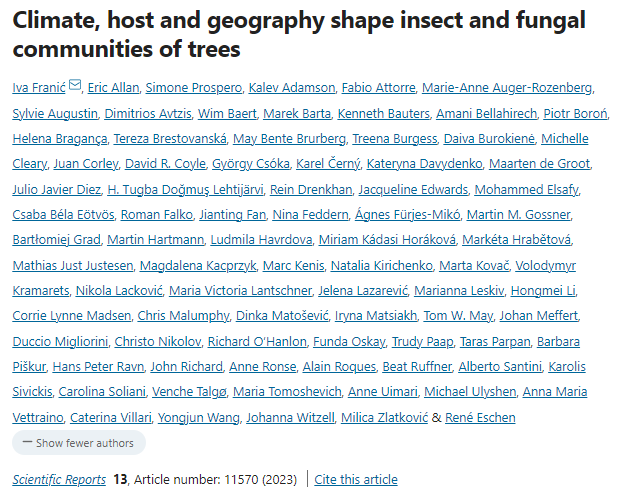Climate, host, and geography responsible for molding forest communities
As climate change and global trade continue to shape our world, it is likely that the relationships between trees and tree-associated organisms will suffer changes, with possible consequences for forest health. In a recent Scientific Reports paper, a consortium of 57 institutions from around the world, including GREEN-IT member and INIAV researcher Helena Bragança, looked into how the climate, host, and geography shape insect and fungal communities of trees.
The team analyzed data from insects and fungi collected from dormant twigs from 155 tree species at 51 botanical gardens or arboreta in 32 countries. The results showed the similar relative importance of studied climatic, host-related, and geographic factors. The team found that the mean annual temperature, phylogenetic distance between hosts, and geographic distance between locations were the major drivers of distinct structures of herbivorous insect and fungal communities associated with trees.
This study is an important step in comprehending and predicting some of the changes that may arise with climate change and globalization. It also highlights that safeguarding trees and forest ecosystems depends on the limitation of the establishment of new forest pests and on increasing the resilience of these ecosystems.
Original paper
Iva Franić, Eric Allan, Simone Prospero, Kalev Adamson, Fabio Attorre, Marie Anne Auger-Rozenberg, Sylvie Augustin, Dimitrios Avtzis, Wim Baert, Marek Barta, Kenneth Bauters, Amani Bellahirech, Piotr Boroń, Helena Bragança, Tereza Brestovanská, May Bente Brurberg, Treena Burges, Daiva Burokienė, Michelle Cleary, Juan Corley, David R Coyle, György Csóka, Karel Černý, Kateryna Davydenko, Maarten de Groot, Julio Javier Diez, H. Tuğba Doğmuş Lehtijärvi, Rein Drenkhan, Jacqueline Edwards, Mohammed Elsafy, Csaba Béla Eötvös, Roman Falko, Jianting Fan, Nina Feddern, Ágnes Fürjes-Mikó, Martin M. Gossner, Bartłomiej Grad, Martin Hartmann, Ludmila Havrdova, Miriam Kádasi Horáková, Markéta Hrabětová, Mathias Just Justesen, Magdalena Kacprzyk, Marc Kenis, Natalia Kirichenko, Marta Kovač, Volodymyr Kramarets, Nikola Lacković, Maria Victoria Lantschner, Jelena Lazarević, Marianna Leskiv, Hongmei Li, Corrie Lynne Madsen, Chris Malumphy, Dinka Matošević, Iryna Matsiakh, Tom W. May, Johan Meffert, Duccio Migliorini, Christo Nikolov, Richard O’Hanlon, Funda Oskay, Trudy Paap, Taras Parpan, Barbara Piškur, Hans Peter Ravn, John Richard, Anne Ronse, Alain Roques, Beat Ruffner, Alberto Santini, Karolis Sivickis, Carolina Soliani, Venche Talgø, Maria Tomoshevich, Anne Uimari, Michael Ulyshen, Anna Maria Vettraino, Caterina Villari, Yongjun Wang, Johanna Witzell, Milica Zlatković, René Eschen. Climate, host and geography shape insect and fungal communities of trees. Scientific Reports, 18 July 2023, DOI: 10.1038/s41598-023-36795-w



